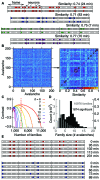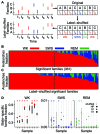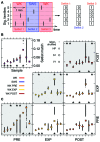Repertoires of Spike Avalanches Are Modulated by Behavior and Novelty
- PMID: 27047341
- PMCID: PMC4802163
- DOI: 10.3389/fncir.2016.00016
Repertoires of Spike Avalanches Are Modulated by Behavior and Novelty
Abstract
Neuronal avalanches measured as consecutive bouts of thresholded field potentials represent a statistical signature that the brain operates near a critical point. In theory, criticality optimizes stimulus sensitivity, information transmission, computational capability and mnemonic repertoires size. Field potential avalanches recorded via multielectrode arrays from cortical slice cultures are repeatable spatiotemporal activity patterns. It remains unclear whether avalanches of action potentials observed in forebrain regions of freely-behaving rats also form recursive repertoires, and whether these have any behavioral relevance. Here, we show that spike avalanches, recorded from hippocampus (HP) and sensory neocortex of freely-behaving rats, constitute distinct families of recursive spatiotemporal patterns. A significant number of those patterns were specific to a behavioral state. Although avalanches produced during sleep were mostly similar to others that occurred during waking, the repertoire of patterns recruited during sleep differed significantly from that of waking. More importantly, exposure to novel objects increased the rate at which new patterns arose, also leading to changes in post-exposure repertoires, which were significantly different from those before the exposure. A significant number of families occurred exclusively during periods of whisker contact with objects, but few were associated with specific objects. Altogether, the results provide original evidence linking behavior and criticality at the spike level: spike avalanches form repertoires that emerge in waking, recur during sleep, are diversified by novelty and contribute to object representation.
Keywords: avalanches; criticality; memory; novelty; patterns; sleep; spikes.
Figures





Similar articles
-
Spike avalanches exhibit universal dynamics across the sleep-wake cycle.PLoS One. 2010 Nov 30;5(11):e14129. doi: 10.1371/journal.pone.0014129. PLoS One. 2010. PMID: 21152422 Free PMC article.
-
Spike-Based Functional Connectivity in Cerebral Cortex and Hippocampus: Loss of Global Connectivity Is Coupled to Preservation of Local Connectivity During Non-REM Sleep.J Neurosci. 2016 Jul 20;36(29):7676-92. doi: 10.1523/JNEUROSCI.4201-15.2016. J Neurosci. 2016. PMID: 27445145 Free PMC article.
-
Spike sequences and their consequences.J Physiol Paris. 2000 Sep-Dec;94(5-6):505-24. doi: 10.1016/s0928-4257(00)01103-7. J Physiol Paris. 2000. PMID: 11165916
-
The organizing principles of neuronal avalanches: cell assemblies in the cortex?Trends Neurosci. 2007 Mar;30(3):101-10. doi: 10.1016/j.tins.2007.01.005. Epub 2007 Feb 1. Trends Neurosci. 2007. PMID: 17275102 Review.
-
The criticality hypothesis: how local cortical networks might optimize information processing.Philos Trans A Math Phys Eng Sci. 2008 Feb 13;366(1864):329-43. doi: 10.1098/rsta.2007.2092. Philos Trans A Math Phys Eng Sci. 2008. PMID: 17673410 Review.
Cited by
-
Oscillatory Patterns of Phase Cone Formations near to Epileptic Spikes Derived from 256-Channel Scalp EEG Data.Comput Math Methods Med. 2018 Nov 21;2018:9034543. doi: 10.1155/2018/9034543. eCollection 2018. Comput Math Methods Med. 2018. PMID: 30728850 Free PMC article.
-
The characteristic patterns of neuronal avalanches in mice under anesthesia and at rest: An investigation using constrained artificial neural networks.PLoS One. 2018 May 24;13(5):e0197893. doi: 10.1371/journal.pone.0197893. eCollection 2018. PLoS One. 2018. PMID: 29795654 Free PMC article.
-
Microscale dynamics of electrophysiological markers of epilepsy.Clin Neurophysiol. 2021 Nov;132(11):2916-2931. doi: 10.1016/j.clinph.2021.06.024. Epub 2021 Aug 2. Clin Neurophysiol. 2021. PMID: 34419344 Free PMC article.
-
Neocortical activity is stimulus- and scale-invariant.PLoS One. 2017 May 10;12(5):e0177396. doi: 10.1371/journal.pone.0177396. eCollection 2017. PLoS One. 2017. PMID: 28489906 Free PMC article.
-
Brain flexibility increases during the peri-ovulatory phase as compared to early follicular phase of the menstrual cycle.Sci Rep. 2024 Jan 23;14(1):1976. doi: 10.1038/s41598-023-49588-y. Sci Rep. 2024. PMID: 38263324 Free PMC article.
References
-
- Abeles M., Bergman H., Margalit E., Vaadia E. (1993). Spatiotemporal firing patterns in the frontal-cortex of behaving monkeys. J. Neurophysiol. 70, 1629–1638. - PubMed
-
- Benjamini Y., Hochberg Y. (1995). Controlling the false discovery rate: a practical and powerful approach to multiple testing. J. R. Statist. Soc. B 57, 289–300.
Publication types
MeSH terms
LinkOut - more resources
Full Text Sources
Other Literature Sources
Research Materials
Miscellaneous

